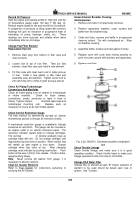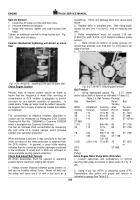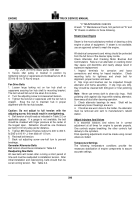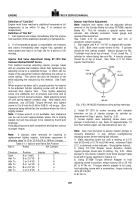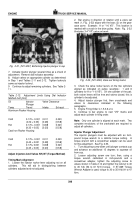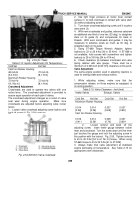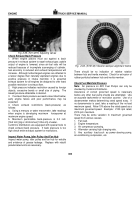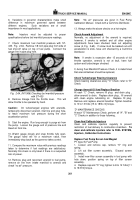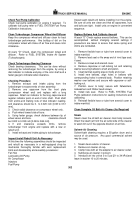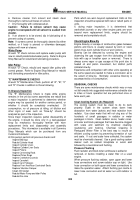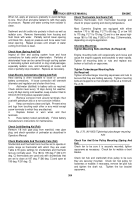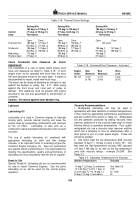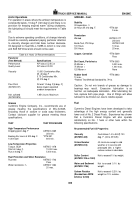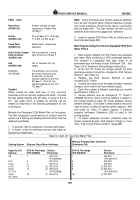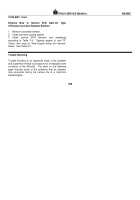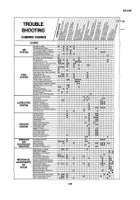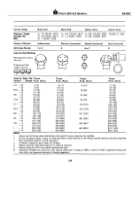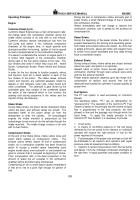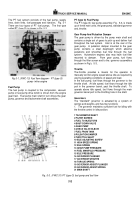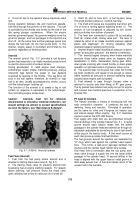TM-5-3805-254-14-P-2 - Page 308 of 894
TRUCK SERVICE MANUAL
ENGINE
When full, apply air pressure gradually to avoid damage
to core.
Shut off air and allow radiator to refill; then apply
air pressure.
Repeat until water coming from radiator is
clean.
Sediment and dirt settle into pockets in block as well as
radiator core.
Remove thermostats from housing and
flush block with water.
Partially restrict lower opening
until block fills.
Apply air pressure and force water from
lower opening.
Repeat process until stream of water
coming from block is clean.
Check Hose (Spring And Fall)
Inspect oil filter and cooling system hose and hose
connections for leaks and/or deterioration.
Particles of
deteriorated hose can be carried through cooling system
or lubricating system and restrict or clog small passages,
especially radiator core, and lubricating oil cooler, and
slow or partially stop circulation.
Replace as necessary.
Clean Electric Connections (Spring And Fall)
Hard starting is often traceable to loose or corroded
battery connections.
A loose connection will overwork
alternator and regulator and shorten their lives.
1.
Add water (distilled) to battery cells as required.
Check solution level every 15 days during hot weather,
every 30 days during cold weather, keep solution filled to
3/8 inch [9.5 mm] above separator plates.
2.
Remove corrosion from around terminals; then
coat with petroleum jelly or a non-corrosive inhibitor.
3.
Keep connections clean and tight.
Prevent wires
and lugs from touching each other or any metal except
screw terminals to which they are attached.
4.
Replace broken or worn wires and their
terminals.
5.
Have battery tested periodically.
Follow battery
manufacturer’s instructions for maintenance.
Check Cold-Starting Aid (Fall)
Remove 1/8 inch pipe plug from manifold, near glow
plug, and check operation of preheater as described in
Operators Manual.
Check Shutterstats And Thermatic Fans (Fall)
Shutterstats and thermatic fans must be set to operate in
same range as thermostat with which they are used.
Table 2-18 gives settings for shutterstats and thermatic
fans as normally used.
The 180 to 195 deg. F [82 to 91
deg. C] thermostats are used only with shutterstats that
are set to close at 187 deg. F [86 deg. C] and open at
195 deg. F [91 deg. C].
Check Thermostats And Seals (Fall)
Remove thermostats from thermostat housings and
check for proper opening and closing temperature.
Most Cummins Engines are equipped with either
medium 170 to 185 deg. F [77 to 85 deg. C] or low 160
to 175 deg. F [71 to 79 deg. C] and in a few cases high-
range 180 to 195 deg. F [82 to 91 deg. C] thermostats,
depending on engine application.
Checking Mountings
Tighten Mounting Bolts And Nuts (As Required)
Engine mounting bolts will occasionally work loose and
cause the engine supports and brackets to wear rapidly.
Tighten all mounting bolts or nuts and replace any
broken or lost bolts or capscrews.
Tighten Turbocharger Mounting Nuts
(As Required)
Tighten all turbocharger mounting capscrews and nuts to
be sure that they are holding securely.
Tighten mounting
bolts and supports so that vibration will be at a minimum.
Fig. 2-70.
Back to Top

